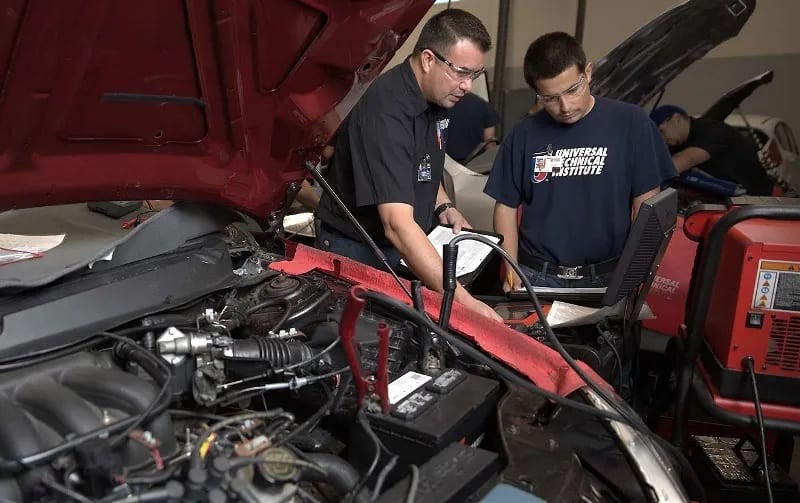Understanding the inner workings of your car might seem daunting, but grasping the basics of its components is incredibly beneficial. Whether you’re aiming to be a more informed car owner, communicate effectively with mechanics, or simply satisfy your curiosity, gaining Basic Car Parts Knowledge is a valuable asset.
Imagine being able to confidently discuss car troubles with a technician, knowing the function of each part they mention. This knowledge empowers you to make informed decisions about maintenance and repairs, potentially saving you time and money. It also fosters a deeper appreciation for the complex machinery that enables your daily commute and adventures.
While we’re not suggesting you need to become a master mechanic overnight, this guide will equip you with foundational knowledge of essential car parts. By understanding their names and functions, you’ll be better prepared to troubleshoot minor issues, understand your car’s needs, and become a more responsible and engaged car owner.
Let’s delve into the fundamental components that keep your vehicle running smoothly.
Essential Car Parts and Their Functions
Having a solid understanding of the main components of your car and their roles is the first step towards basic car parts knowledge. This foundational understanding will be invaluable as you navigate car ownership and maintenance.
Engine
The engine is unequivocally the heart of your vehicle. Whether it’s a traditional internal combustion engine or a modern electric motor, its primary function is to generate the power needed to propel your car.
Most cars on the road today are equipped with internal combustion engines (ICE). These engines operate by burning a mixture of air and fuel within cylinders. This combustion creates pressure that moves pistons, which in turn rotate the crankshaft, ultimately generating power. There are different types of ICEs, including gasoline and diesel engines, each with its own characteristics and fuel efficiency.
Increasingly, electric vehicles (EVs) are gaining popularity. Instead of combustion, EVs utilize electric motors powered by rechargeable batteries. Electric motors convert electrical energy into mechanical energy, providing instant torque and often resulting in quicker acceleration compared to their gasoline counterparts. Regardless of the type, the engine is indispensable; without it, your car simply won’t move.
Battery
The car battery is much more than just a source to start your engine. It plays a crucial role in powering various electrical systems throughout your vehicle. When you turn the ignition, the battery delivers the initial surge of electricity needed to crank the engine to life.
Beyond starting, the battery also provides power to accessories like headlights, interior lights, the radio, and the car’s computer systems, especially when the engine is off or at low speeds. A failing battery can manifest in several ways, such as a slow engine crank, dim headlights, or needing jump starts. Regular battery checks are essential to avoid being stranded with a dead battery.
Alternator
While the battery provides the initial power, the alternator takes over once the engine is running. The alternator is essentially a generator driven by the engine, responsible for producing electricity to power your car’s electrical systems and, crucially, to recharge the battery.
The alternator converts mechanical energy from the engine’s rotation into electrical energy. This continuous charging action ensures that the battery remains topped up, and all electrical components receive the necessary power while the car is in operation. Symptoms of a failing alternator can mimic a bad battery – dimming lights, difficulty starting, and even stalling. Ignoring alternator issues can lead to battery drain and eventual breakdown.
Brakes
The braking system is paramount for safety, allowing you to slow down and stop your vehicle effectively. Modern cars primarily utilize either disc brakes or drum brakes, or a combination of both.
Disc brakes, commonly found on front wheels and sometimes all four, employ calipers to squeeze brake pads against rotors, creating friction to slow the wheels. Drum brakes, often on rear wheels, use brake shoes that press outwards against the inside of a drum to generate braking force. Components within both systems, such as brake pads, shoes, rotors, and drums, wear down over time due to friction. Unusual noises like squealing or grinding, or changes in brake pedal feel, are indicators to have your brakes inspected promptly.
Radiator
Engine combustion generates significant heat, and managing this temperature is vital to prevent overheating and engine damage. The radiator is a key component of the engine’s cooling system, designed to dissipate excess heat.
The radiator works by circulating coolant, a specialized liquid, through the engine block. As coolant absorbs heat from the engine, it flows to the radiator. The radiator then cools the hot coolant as air passes through its fins, before it’s recirculated back to the engine to absorb more heat. Maintaining proper coolant levels is crucial for radiator efficiency and engine health. Regular checks and coolant flushes are recommended to ensure the cooling system operates optimally and prevents engine overheating, which can lead to severe damage.
Transmission
The transmission, often referred to as the gearbox, acts as the intermediary between the engine and the wheels. Its primary function is to transfer the engine’s power to the wheels in a controlled manner, enabling the car to move at various speeds and torques.
Transmissions come in two main types: manual and automatic. Manual transmissions require the driver to manually shift gears using a clutch and gear lever, providing more driver control. Automatic transmissions, on the other hand, shift gears automatically based on speed and engine load, offering convenience. Regardless of the type, transmissions contain intricate sets of gears that multiply engine torque and adjust engine speed to wheel speed. Regular transmission fluid changes, as per manufacturer recommendations, are essential for lubrication and preventing wear and tear within the transmission.
Shock Absorbers
Shock absorbers are vital components of the suspension system, contributing to ride comfort, vehicle stability, and effective braking. Their primary role is to control the movement of the suspension springs and dampers, preventing excessive bouncing and oscillations.
By damping suspension movement, shock absorbers ensure that your tires maintain consistent contact with the road surface. This is crucial for maintaining traction, especially during cornering and braking. Worn shock absorbers can lead to a bouncy ride, reduced handling, uneven tire wear, and increased braking distances. If you notice your car bouncing excessively after bumps or feeling unstable in corners, it might be time to have your shock absorbers checked.
Catalytic Converter
In the pursuit of cleaner emissions, the catalytic converter plays a critical role. It’s a key component of the exhaust system, designed to reduce harmful pollutants present in the engine’s exhaust gases before they are released into the atmosphere.
The catalytic converter utilizes chemical reactions to convert pollutants like carbon monoxide, hydrocarbons, and nitrogen oxides into less harmful substances like carbon dioxide, water, and nitrogen. Located in the exhaust system, it works silently to minimize the environmental impact of your vehicle’s emissions. A malfunctioning catalytic converter can lead to reduced engine performance, decreased fuel efficiency, and failure to pass emissions tests.
Components of a Car & Their Functions FAQs
How are car parts labeled or identified?
Car parts are meticulously labeled and identified for efficient tracking, cataloging, and replacement. Manufacturers assign unique part numbers to each component. You’ll often find OEM (Original Equipment Manufacturer) labels, indicating parts made by the original car manufacturer, or aftermarket labels for parts from other suppliers. Modern parts increasingly incorporate barcodes or QR codes for digital tracking and inventory management.
How many parts are in a car?
The sheer complexity of a modern car is reflected in the staggering number of parts it comprises. While the exact figure varies based on make, model, and vehicle complexity, estimates typically range from 30,000 to 40,000 individual components. This vast number underscores the intricate engineering and manufacturing involved in producing a functional vehicle.
Learn Even More About Parts of a Car at UTI
Now that you’ve expanded your basic car parts knowledge, are you intrigued to delve deeper into the world of automotive technology? This newfound interest could be a sign that a career as an automotive technician is the right path for you! Imagine working hands-on with these components and systems every day.
At Universal Technical Institute (UTI), our comprehensive Automotive Technology program provides the expert-led training you need to diagnose, maintain, and repair a wide range of vehicles, both domestic and imported. We also offer specialized training programs in partnership with leading automotive brands, giving you a competitive edge in the industry. From engine diagnostics to advanced emissions control, our hands-on courses equip you with the practical skills and in-depth knowledge sought after by employers.
Our accelerated programs allow you to graduate in less than a year, getting you career-ready quickly. Invest in your future and gain the expertise to pursue a fulfilling career you’re passionate about – all while becoming even more knowledgeable about your own car!
Ready to explore the possibilities? Request more information from our Admissions Representatives or call us today at 1-800-834-7308.
UTI Campuses That Offer Automotive Technician Training
[UTI Campus Locations Image Placeholder – Replace with actual image or list]
START YOUR EXCITING AUTOMOTIVE CAREER TODAY.
- Hands-on training: Get practical experience with industry-leading brands.
- Flexible start dates: Classes begin every 3-6 weeks.
- No obligation: Get your questions answered without pressure.
Related Articles
[
Advancing vs. Retarding Ignition Timing: Key Differences](/blog/automotive/ignition-timing)Ignition timing will affect engine performance. Find out how it works and the difference between advancing and retarding here!
]
[
The Difference Between an Automotive Mechanic and an Automotive Technician](/blog/automotive/the-difference-between-a-mechanic-and-an-automotive-technician)Learn the distinction between an automotive mechanic and an automotive technician. Read our blog to find out why these differences are important to understand!
]
[
ASE Certification: How To Become ASE Certified (Definitive Guide)](/blog/tips/mechanic-path-ase-certification)ASE certifications can boost the careers of automotive, diesel and collision repair techs. Learn the benefits and how to become ASE certified here!
]
*Disclaimer:
1 ) UTI is an educational institution and cannot guarantee employment or salary.
2 ) For program outcome information and other disclosures, visit www.uti.edu/disclosures.
7 ) Some programs may require longer than one year to complete.
18 ) UTI now offers blended-learning formats for automotive, diesel, motorcycle and marine technician training, combining online lectures with hands-on lab training.
Universal Technical Institute of Illinois, Inc. is approved by the Division of Private Business and Vocational Schools of the Illinois Board of Higher Education.

